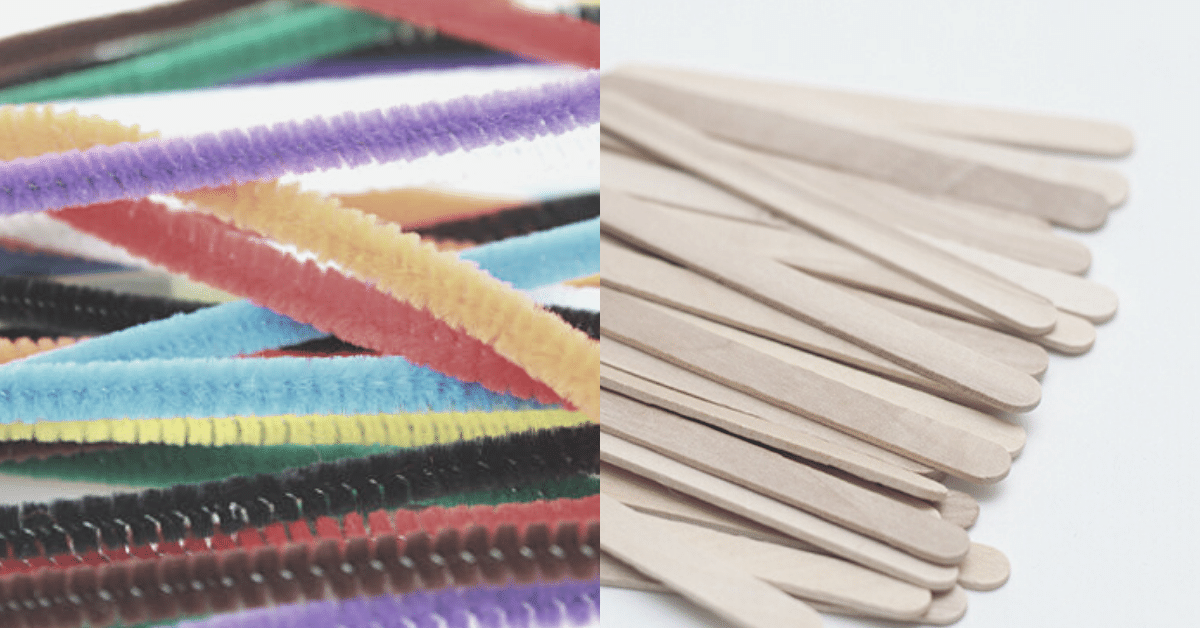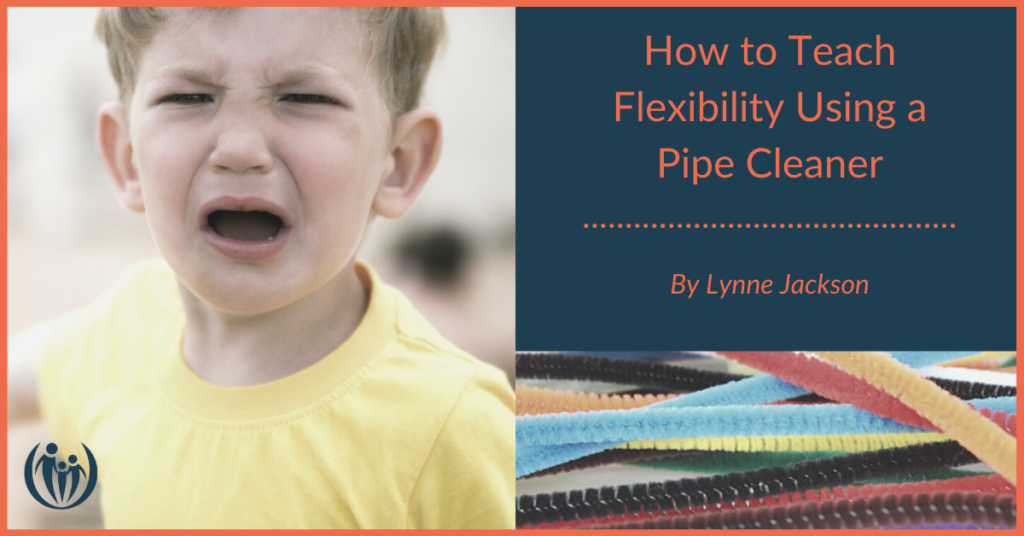
How to Teach Flexibility Using a Pipe Cleaner

Plans change. Life changes. And suddenly your sweet child who doesn’t get to have chicken nuggets is melting down on your kitchen floor. Or maybe rain canceled your walk to the park. Whatever the cause, the chaos that ensues can test the most patient parents. Teaching flexible thinking to a child is NOT easy.
The good news: We’ve got an activity to teach flexible thinking to little concrete thinkers.
Why is flexible thinking so difficult for some children?
When plans change, being flexible can be really hard for everyone, but especially for kids. When brains go into fight-or-flight, flexibility can be one of the first things to go.
For some kids, there is a pre-programmed response to yell, attack, or defend when life throws them an upsetting change in plans. Even if that upsetting change is simply their favorite shirt in the wash or the discovery that someone messed with their Legos.
You might even think, “Seriously?! This is not that big of a deal!” But to your child it is. They are stuck in the perspective that disaster has happened.
What is cognitive flexibility?
Cognitive flexibility, otherwise known as flexible thinking, is the ability to change how you think about something. When a circumstance changes, cognitive flexibility helps you gain a new perspective and replace your old goal with a new goal.
Picture this: If “The Unexpected Circumstance” was an object on your table, you could walk around to the other side to take a look. You would then be able to figure out a new way to respond, based on that new perspective.
For example, your goal was to make chocolate chip cookies. But then you went to the cupboard and discovered you were out of chocolate chips. Healthy flexibility allows you and your child to see this as an opportunity for problem-solving (new perspective).
Flexible thinking allows you to broaden your goal to a new goal: Have fun making some kind of tasty treat with the ingredients you have on hand.
A child with rigid thinking may not be able to do this. Kids who are prone to perfectionism often struggle with flexibility because, of course, there’s only one way for things to be “perfect”.
The inability to see a new perspective and a new goal can lead to enormous waves of emotion. This is what brings about an outburst that offloads their disappointment and stress, and might bring you to your knees in exhaustion. The outburst is miserable for everyone, including the child. If this dynamic describes your child, you’re not at all alone in the struggle.
Why object lessons are a valuable activity for kids
Kids need visuals. They need to be able to understand a principle in something they can see or at least imagine. Even when teaching more abstract-minded adults, Jesus often used parables about physical objects to teach spiritual or relational principles, such as fig trees, mustard seed, or a grain of wheat.
Simple object lessons can be extraordinarily helpful! If you haven’t ever tried using objects to teach valuable lessons, now could be a great time to start! [Check out our other articles using oranges, dollar bills, and paper plates.]
Why Kelli was ready for an activity to teach flexible thinking
You’ll be encouraged, inspired, and equipped by this story from Kelli about her 4-year-old son Noah. Kelli had tried everything to stop his outbursts, but everything she did seemed to make things worse. I worked with Noah in an occupational therapy clinic, and I gave Kelli this idea for an activity to teach flexible thinking. This is her story:
“Unexpected changes were very difficult for Noah. He once screamed for 45 minutes due to an unexpected command to stop pedaling his bike and wait! Mealtimes were particularly tough. If we said we were having chicken for supper, he might think it was chicken nuggets. Then when he came to the table and saw chicken breast, he would scream, “That’s not what I wanted!! I wanted chicken nuggets!” and he’d get so upset he’d refuse to eat. If his favorite team jersey was in the wash, it was a “meltdown in the making” and he could tear his closet apart in his frustration.
I was very discouraged in those days. I can remember sitting in the clinic crying during one of Noah’s O.T. sessions. It was so hard and I just wanted to know that my son could become a happy, productive little boy without all the crazy that we were experiencing!
When you (Lynne) suggested this activity, I was eager to try something proactive because I could see that my frustrated reactions were keeping us stuck. I waited for a calm teaching moment so he’d be ready to learn.“
The activity: Pipe cleaners and sticks
This is the object lesson that I taught Kelli, and I’m excited to share with you. You’ll need to gather a couple items and look through the activity before jumping in. Like Kelli, choose a calm moment to teach your child.
Materials Needed:
- 1 popsicle stick or twig from a tree
- 1 pipe cleaner
Instructions:
- Show your child the stick.
- Talk about how sometimes people want things to go their way, or according to their plan. If plans change, they explode.
- Tell your child, “That’s being rigid, like this stick.”
- As you press on the stick, continue: “When rigid people don’t get what they want or what they expect, they keep trying to go back to the original plan. Until they, BOOM, explode.”
- Snap the stick.
- Show your child the pipe cleaner.
- Talk about how other people can bend and adjust as situations change. Give examples of how people change:
- Eating a different cereal in the morning, when your favorite runs out
- Sharing a favorite toy when a friend comes over
- Finding other fun things to do when rain cancels a trip to the zoo
- Say to your child, “That’s being flexible like this pipe cleaner. It can bend when it needs to and then straighten back out again like it was. A person that can do that is flexible.”
- Talk about how other people can bend and adjust as situations change. Give examples of how people change:
- Point out successes by sharing examples of times when your child has been flexible.
- Resist pointing out when your child has been more like a “stick”. Instead, share with them about times when you struggled to be flexible and what was the result, and how you’ve learned to be more flexible over time.

Focus is fertilizer
Kelli focused on Noah’s successes by reminding him of their family vacation where he had tolerated all sorts of schedule changes and travel stress like a trooper. She encouraged him, “You were so flexible, and that helped everyone have a great time!” That night at dinner Noah used the pipe cleaner and another stick to teach the rest of the family about being flexible or rigid, repeating his story about his vacation flexibility.
When Noah was asked to teach his family about being flexible it actually encouraged him to be more flexible, because giving advice increases self-confidence and performance. Consider prompting your kids to teach the family what they’ve learned.
Later Kelli watched for other little times when Noah was flexible and reminded him of how helpful and grown-up it was when he did that. As we frequently say at Connected Families, “Focus is fertilizer,”. (Whatever we focus on, notice, and affirm, we’ll get more of.)
Noah learned flexibility
Noah took this lesson to heart! This simple object lesson continued to reap benefits for their family for a long time. When implementing this object lesson in your own family, learn from Kelli’s experience.
Give kids a heads up when change is coming
Kelli shared,
Noah’s own prediction of success helped him to be flexible in those situations.
Guiding questions can promote flexible thinking
When an opportunity for flexibility emerges, you could help your child by asking guiding questions:
- What’s a different way to look at this? (When rain cancels the zoo, I can find other ways to have fun.)
- What’s a broader goal you might have? (To have a good time together at big muscle play.)
- How could we achieve that new goal?” (Make an obstacle course with our hop balls and jump in a big pile of pillows.)
Your child really can learn flexibility
Kelli gave us an update, saying,
What a beautiful story! Kelli used creativity to teach her son flexible thinking that will serve him well for the rest of his life.
Note for parents of older kids: If this activity feels too contrived for an older child, you can just tell Noah’s story. Alternatively, talk about the difference between these rigid and flexible objects, while comparing the objects to real-life scenarios. Look for any possible examples of your child’s flexibility to affirm and talk about the benefit of that flexibility.
Noah’s story perfectly illustrates that oftentimes children misbehave because they lack the skills and self-confidence to behave appropriately. But when parents take the time to teach and affirm these important life skills, it empowers kids to make wise choices that will help them thrive in life.
When you see even the tiniest glimmer of emerging flexibility, self-control, and wisdom, remember to point out (and celebrate!) those gains, so your child learns to value those skills.
The one who gets wisdom loves life… Proverbs 19:8a
Hold on to HOPE!
If you relate to Kelli’s tears and fears about her child’s future, you are not alone. But if you give up hope, your child will almost certainly sense it and do the same. There is plenty of HOPE!
May the God of hope fill you with all joy and peace as you trust in him, so that you may overflow with hope by the power of the Holy Spirit.
Romans 15:13
One year later: Noah at age 5
Kelli sent me her story almost nine years ago. We are excited to share some snapshots of Noah’s progress in flexibility over time to encourage you! This is what she sent to me a year after the original story.
Once in a while, we have to help him but he has definitely made HUGE improvements on his own. We usually take that opportunity to affirm him for being flexible, and he is usually pretty proud of himself. It goes a little like this:
Us: “Wow, Noah thanks for being so flexible about this.”
Noah: “Yeah, it’s no big deal. I can do it this way instead.”
Through your help and God’s strength, we are in a much better place. And it’s so fun to see Noah be so grown up about things that he literally had no idea how to cope with before (and neither did we for that matter!)
[Side note: During this time Kelli also worked on decreasing Noah’s sensory challenges and anxiety by doing a deep pressure touch program when he was one of my OT clients. Noah is actually the “star” of this sensory input video which has equipped hundreds of thousands of parents.]
Keep in mind, this much progress took a year. Not a week, or even a month. It takes time to change brain pathways and build skills, so stick with it and give you and your child lots of grace along the way!
9 years later: Noah at age 13
Kelli has some final words for you…
“You tell those emotional mamas they can do hard things! And that it will not be perfect, but it will be ok! God didn’t give us these intense kids for nothing!”
More resources that will help teach flexibility
- Helping Your Highly Sensitive Child
- What you Misunderstand About Your Misbehaving Child
- Game: Fairytale Fluxx (teaches flexibility in a card game where the rules (and goals) are constantly changing!)
Download our FREE in-depth ebook Helping Kids With Anger. It will provide thoughtful insights and creative ideas to help your struggling child.






